Contents
Market Overview
Macro Review
Russia’s military offensive continues as the third round of talks are set for this weekend. The ruble weakened 23% this week as Russian equity markets were closed and capital controls were introduced. Global markets were spooked further on Friday as Energatom’s nuclear power plant was struck by shelling in the Zaporizhzhia Oblast, which has a nameplate capacity of 5.7GW (the largest in Europe). This prompted emergency IATA, G7, NATO and UN ministerial meetings. The global impact on Friday was noticeable as the 10-year U.S. Treasury note gapped 15 bp tighter to 1.69%, the VIX touched 34 ppts, EURUSD declined below 1.10 and Eurozone banks declined 19% over the week. Voluntary sanctions were also applied to Russia as a number of companies across energy, retail and automotive sectors cut ties with Russia. This comes as rating agencies such as S&P, Fitch and Moody’s cut the sovereign by 6-8 notches into deep high yield territory, having been a stable investment grade issuer until late February. On top of that, Russian equities were removed from MSCI and FTSE Russell indices, de-listed on the LSE and DAX exchanges and even Bank of America removed Russian securities from its fixed income ICE indices. JP Morgan stands out but they have at least begun a consultation survey, which will conclude on Monday and will aim to address when or if Russian securities will be excluded from the EMBI, CEMBI and GBI-EM indices. A further consultation is under review by Markit regarding the new CDX EM Series 37 roll, with the prospectus of Russian CDS being removed from the index (it currently has a 6% weight). The loss of capital market access has already seen sell-side institutions revise Russia’s forecasted GDP down by 10-20% and revise inflation to far higher levels. In any event, Wednesday’s Russian CPI inflation release is too soon to capture recent moves.
EM Credit Update
Emerging market sovereign credit ended the week down 2.6%, with credit spreads widening 49 bp. Outperformers over the week were Zambia, Georgia and Saudi Arabia, while Belarus, Ukraine and Russia underperformed again. One surprise that stood out was EM exchange traded fund inflows of $503m on Wednesday, which kept the market buoyant, although confirmation of EPFR outflows over the week of $1.5 bn created some panic. Away from CEEMEA, the LATAM market was more upbeat and the primary issuance market was open. Chile has become the first emerging market sovereign to issue a sustainability-linked bond, with a coupon that can step-down by 12.5 bp if GHG emissions decline. This is a first for EM sovereigns with direct links to structural elements of bond cash flows and follows Brazil’s Suzano, which was the first EM corporate to do so in September 2020 (via the 2031s bond).
The Week Ahead
The main monetary policy meeting rests with the ECB next Thursday. Incidentally, the ECB rate decision is the same day as the U.S. CPI release. Before that, China’s National People’s Congress meets over the weekend and the barrage of data releases from inflation, credit and trade data comes early next week. Meanwhile, EU accession talks will begin on Thursday over Ukraine’s membership application. Interest rate decisions are also due from Kazakhstan (13.5%), Pakistan (9.75%), Peru (3.5%) and Poland (2.75%). Beyond that, EM inflation is the main theme with releases out of Brazil, Chile, Colombia, Czech Republic, Hungary, Mexico and then Russia. Finally, South Africa’s GDP will follow after the recent Medium-Term Budget Policy Statement, where consensus is 1.8%, which will be closely watched after Brazil beat expectations by some 40 bp.
Highlights from emerging markets discussed below include: Russia intensifies aerial bombardment of Ukraine amid slow progress on the ground; severe Western sanctions could be dialed up further if destruction and civilian casualties mount; Argentina and IMF officially reach Staff Level Agreement; congressional discussion begins; and Global emerging markets corporates in focus: Disentanglement
Fixed Income
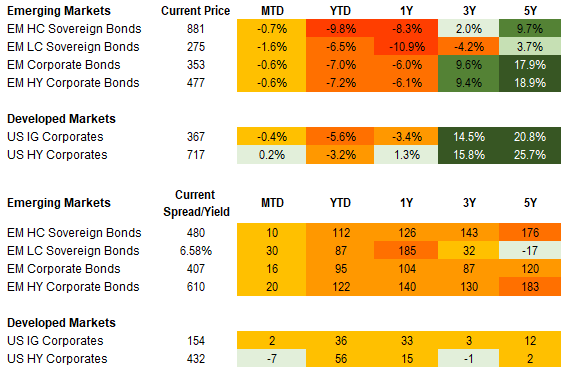
Equities
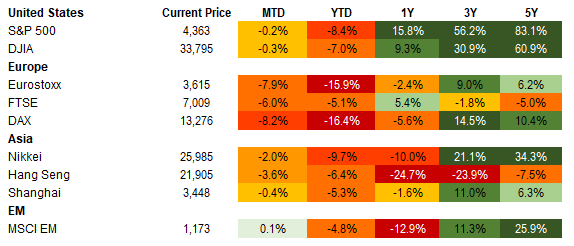
Commodities

Source for data tables: Bloomberg, JPMorgan, Gramercy. EM Fixed Income is represented by the following JPMorgan Indicies: EMBI Global, GBI-EM Global Diversified, CEMBI Broad Diversified and CEMBI Broad High Yield. DM Fixed Income is represented by the JPMorgan JULI Total Return Index and Domestic High Yield Index. Fixed Income, Equity and Commodity data is as of March 4, 2022 (mid-afternoon).
Emerging Markets Weekly Highlights
Russia intensifies aerial bombardment of Ukraine amid slow progress on the ground; severe Western sanctions could be dialed up further if destruction and civilian casualties mount
Event: More than a week into Russia’s invasion of Ukraine, Kyiv and other main population centers remain under Ukrainian control as Russian ground forces make slow progress against Ukraine’s fierce and proficient defense. Russia’s aggression appears to have unified the West, as evidenced by strong coordinated sanctions, including freezing a substantial portion of Russia’s foreign exchange reserves by G-7 jurisdictions. Increasing bombing of Ukrainian cities and civilian infrastructure by Putin’s forces is likely to drive a deepening humanitarian crisis as well as further economic and political isolation for Russia.
Gramercy Commentary: Ukraine’s defiance in the face of Russia’s military onslaught has unleashed a flood of global political, financial, and military support. In line with our expectations, Russia appears to be paying a high price for Putin’s decision to attack Ukraine. Heavy Russian losses in terms of lives and equipment are being reported by Western and Ukrainian sources amid a series of logistical challenges and severe resistance by Ukraine’s highly motivated and well-armed defenders. Having been stopped in its attempted “Blitzkrieg” ground offensive to “decapitate” Ukraine’s government, the Russian military has shifted its tactics to heavier air and artillery bombardments, causing increased civilian casualties and large-scale infrastructure damage. As Ukraine seems well positioned to retain control of Kyiv and other major population centers, fighting appears likely to intensify in coming days, potentially triggering an increasingly difficult humanitarian situation on the ground and deepening the global economic and political isolation of Russia. Two rounds of exploratory talks between the two sides have failed to produce any breakthroughs amid continuing Russian offensives and the Kremlin’s maximalist demands (i.e. regime change and “demilitarization of Ukraine”) which remain unacceptable to Ukraine unless forced by a decisive military defeat. The situation in Ukraine continues to be highly fluid and unpredictable, but we believe a scenario in which Russia is successful in taking control over the entire country is increasingly unlikely. Once the acute phase of the conflict is over, Ukraine’s economic recovery will hinge on the extent of infrastructure damage sustained and maintaining control over key productive assets, including access to the Black Sea coast where we expect the brunt of Russia’s offensive to focus on next. In any scenario, we expect massive international financial support for Ukraine to materialize during the conflict and in its aftermath. As for Russia, the likelihood that the country is going to become a global “pariah” increases for as long as Russian forces occupy internationally recognized Ukrainian territories, even when active hostilities end. However, some newly imposed sanctions could start to be rolled back in exchange of Russian concessions in future peace negotiations.
Argentina and IMF officially reach Staff Level Agreement; congressional discussion begins
Event: The IMF published its long-awaited press release on the official staff level agreement with the Argentine authorities on a 30-month, $45 bn Extended Fund Facility (EFF). The program aims to provide budget and balance of payment support by refinancing the government’s maturities with the Fund while tackling inflation and socio-economic challenges through a multi-pronged approach. Board level review and approval is expected to occur after Argentina’s domestic debate in Congress, which began on Thursday.
Gramercy Commentary: The development is constructive as it confirms the deal announced by the authorities earlier in the year. While the domestic debate and board approval could take up to, or just beyond, the nearly $3 bn March 22 repayment to the Fund to conclude, we believe the official IMF staff level agreement eliminates the risk of any disruptive arrears scenario. Accordingly, ceteris paribus should be supportive to asset prices. The gap between the parallel and official FX rates has dropped to just below 90% and we anticipate this will continue to narrow into mid-year as a result of better sentiment linked to the IMF resolution, strong harvest related flows, and incrementally swifter official depreciation although with periods of volatility and gap widening depending on policy execution as the year progresses.
Global emerging markets corporates in focus: Disentanglement
Event: Russia’s invasion of Ukraine has led authorities in the U.S., EU, UK, Canada, and elsewhere to impose a whole raft of new sanctions on issuers, sectors, and even the sovereign. The impact of actions taken in Ukraine and of the announced sanctions is significant, reaching many more countries, sectors and issuers than those named on the sanctions lists.
Gramercy Commentary: The rise in commodity prices has received the most focus, though this has impacted emerging markets corporates both positively and negatively, depending on what industry these corporates operate in. It also appears that coal might be making a comeback (some may argue that it never really went away). Even after COP26, heating, manufacturing and other commodity-dependent needs across both emerging and developed markets may require changes in the mix of fuel and inputs, at least until tensions ease in Russia and Ukraine. Added to this, legal and compliance costs will likely increase as banks, corporates and others seek to ensure they do not fall foul of any sanctions regimes. Ownership changes are another side effect – we have already seen some sanctioned entities and individuals transfer or dispose of holdings in various entities. There may also be changes in debt and equity index weights across emerging markets where Russian securities have been, or are to be, removed. Further, as some banks have now been barred from SWIFT, payments for goods and services may be disrupted even where there are licenses exempting some payments from the restrictions. The adoption of alternative financial messaging systems developed in China and elsewhere will be closely watched. The impact on bond markets is also worth highlighting. Primary activity has slowed since headlines regarding Russia’s activity in Ukraine first broke, and it will be difficult (or at the very least, more expensive) for all but the highest-rated, most resilient issuers to access the international bond markets while uncertainties around the Russia-Ukraine situation persist. This makes existing liquidity and access to alternative sources of funding even more important. There is less talk of significant rate hikes in some markets now. This may impact margins at banks and borrowing costs at non-financial issuers. In other markets, more aggressive rate hikes could be needed to address the impact of these tensions on local currencies. Some companies have chosen to exit Russia or suspend Russia-related activity even though sanctions do not explicitly require them to do so. These decisions may impact corporates which acted as suppliers to those issuers or were reliant on issuers which have altered their Russia strategy in other ways. Finally, there will likely be an even greater focus on social and governance factors, with more scrutiny of Russia-related investments on these grounds. Authorities in the U.S., EU, and elsewhere have said there is the potential to impose additional sanctions. In this context, the process of disentangling (some) Russian assets from the parts of the emerging markets universe where these restrictions apply has probably only just begun.
Emerging Markets Technicals
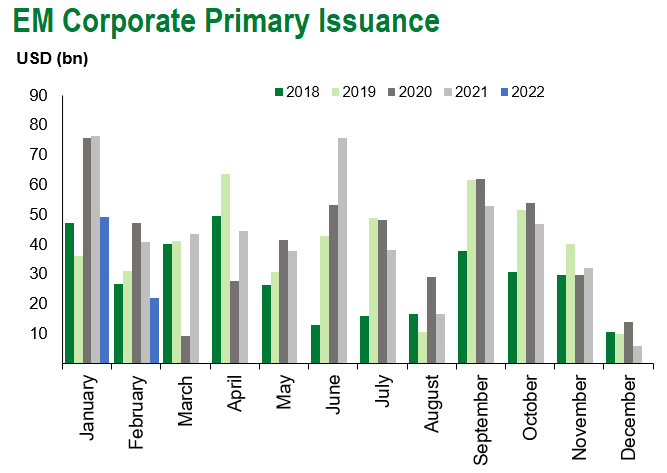
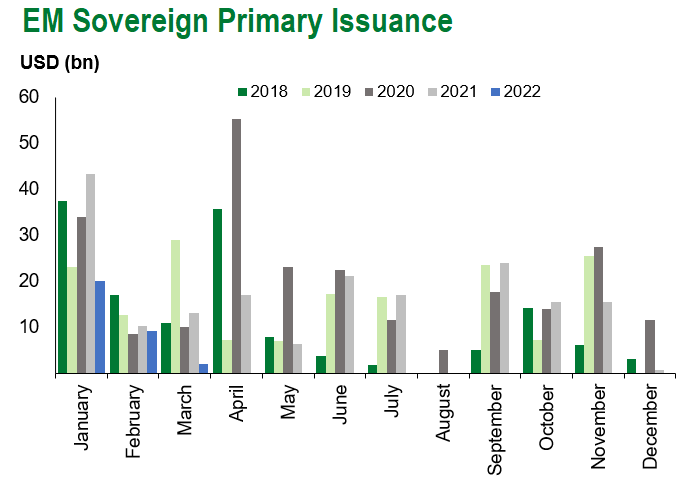
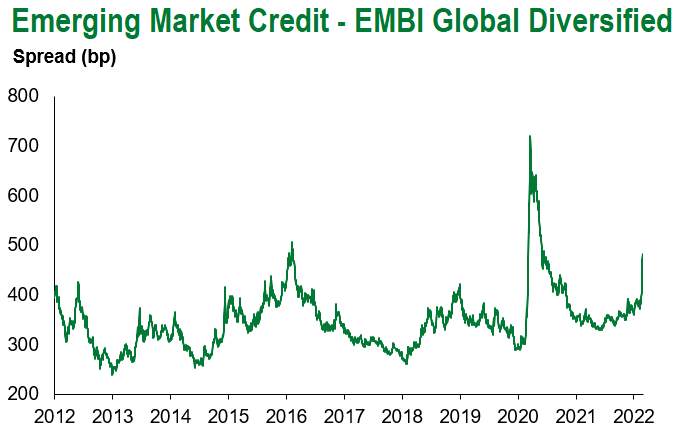
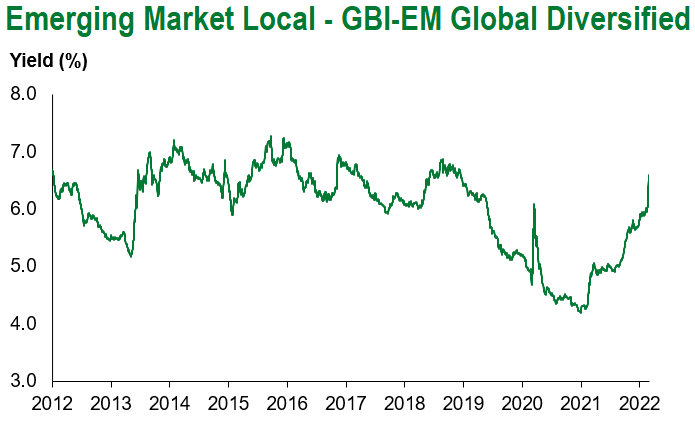
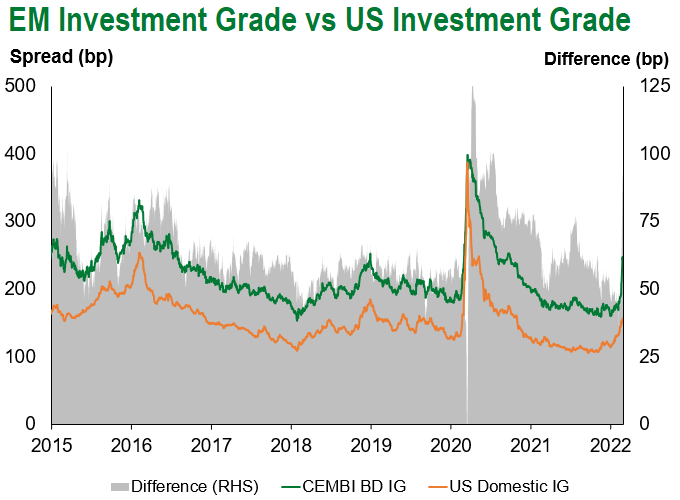
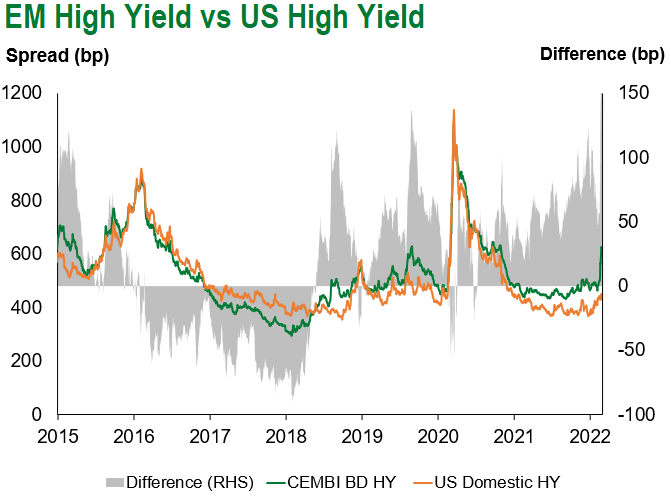
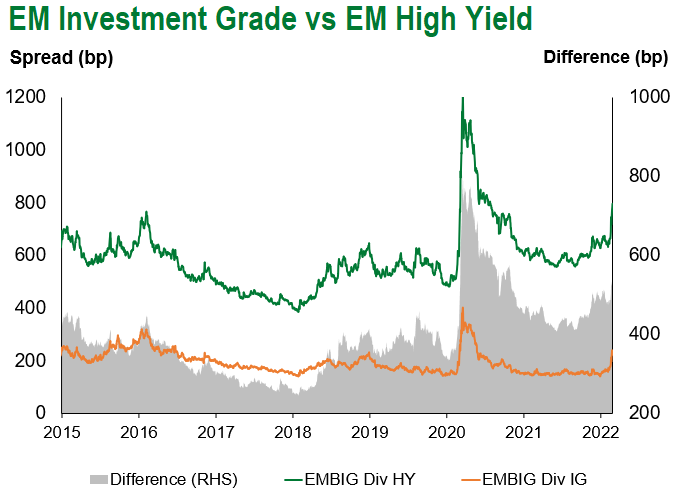
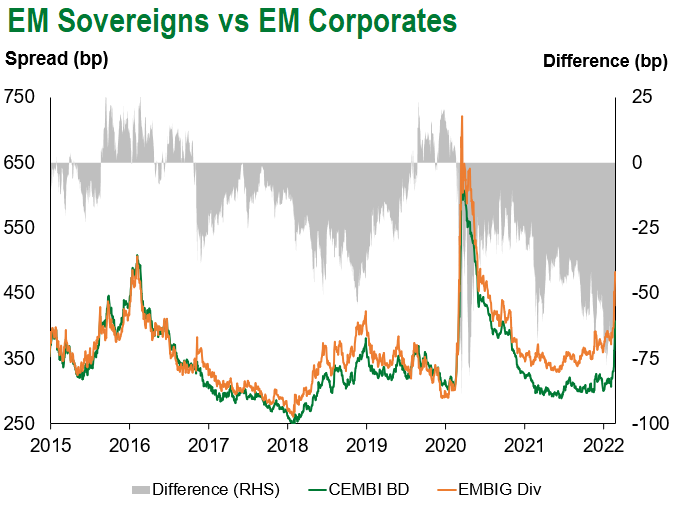
Emerging Markets Flows
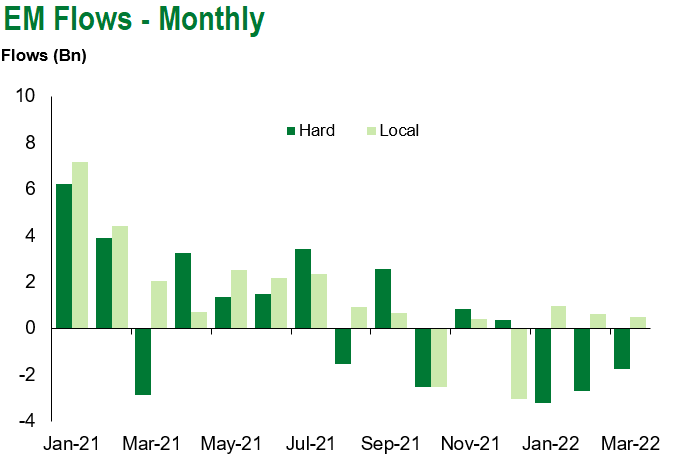
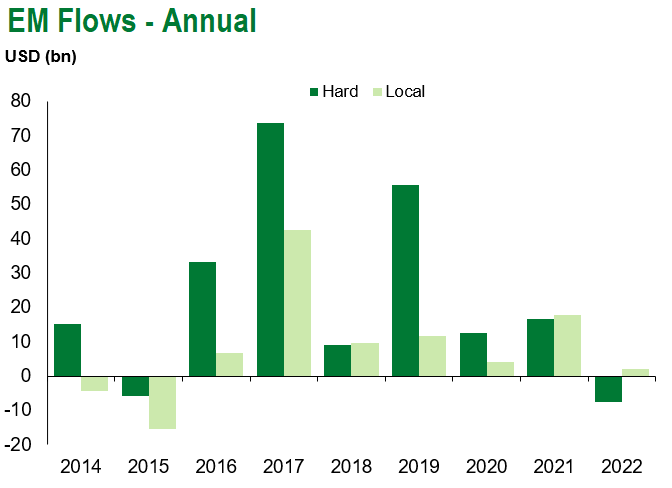
Source for graphs: Bloomberg, JPMorgan, Gramercy. As of March 4, 2022.
COVID Resources
Emerging Markets COVID-19 Case Summary
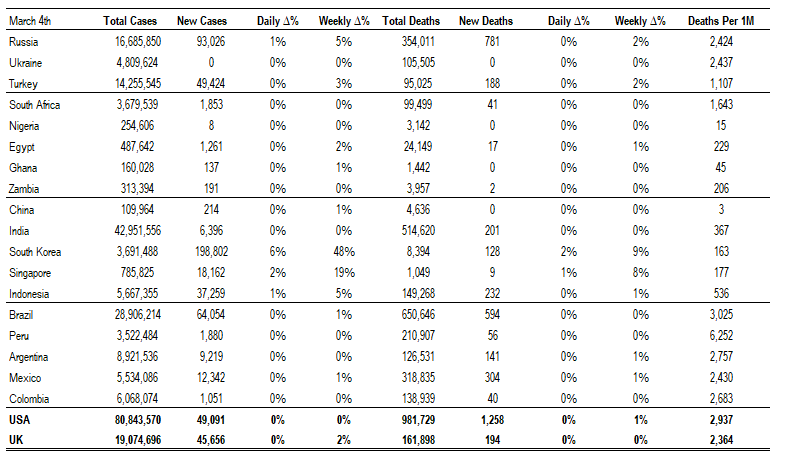
Source: Worldometer as of March 4, 2022.
Additional Crisis Resources:
Johns Hopkins COVID-19 Case Tracker
For questions, please contact:
Kathryn Exum, CFA ESG, Senior Vice President, Sovereign Research Analyst, [email protected]
Petar Atanasov, Senior Vice President, Sovereign Research Analyst, [email protected]
Tolu Alamutu, CFA, Senior Vice President, Corporate Research Analyst, [email protected]
James Barry, Vice President, Corporate Research Analyst, [email protected]
This document is for informational purposes only. The information presented is not intended to be relied upon as a forecast, research or investment advice, and is not a recommendation, offer or solicitation to buy or sell any securities or to adopt any investment strategy. Gramercy may have current investment positions in the securities or sovereigns mentioned above. The information and opinions contained in this paper are as of the date of initial publication, derived from proprietary and nonproprietary sources deemed by Gramercy to be reliable, are not necessarily all-inclusive and are not guaranteed as to accuracy. This paper may contain “forward-looking” information that is not purely historical in nature. Such information may include, among other things, projections and forecasts. There is no guarantee that any forecasts made will come to pass. Reliance upon information in this paper is at the sole discretion of the reader. You should not rely on this presentation as the basis upon which to make an investment decision. Investment involves risk. There can be no assurance that investment objectives will be achieved. Investors must be prepared to bear the risk of a total loss of their investment. These risks are often heightened for investments in emerging/developing markets or smaller capital markets. International investing involves risks, including risks related to foreign currency, limited liquidity, less government regulation, and the possibility of substantial volatility due to adverse political, economic or other developments. The information provided herein is neither tax nor legal advice. Investors should speak to their tax professional for specific information regarding their tax situation.